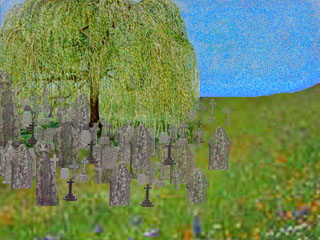The Tree of Life & Death
by Amy Lenzo
An archetypal image came to me once, in a dream I had as a young girl. It was an ancient willow tree, set in a graveyard; its graceful branches sweeping down in an arc to caress the earth and headstones at its feet. This dreamscape was saturated with vivid color, and a pulsating light suffused the entire scene. It was an old graveyard, like you’d find down some forgotten country lane, or in the grounds surrounding an old English churchyard, overgrown with grass, moss and wildflowers. The ground growth was reaching in a vital movement upward; vines stretching to wrap themselves around great angel-decorated tombstones, while the willow arched down to meet them.
You could almost trace the life force, moving as bands of light pulsating through the scene. Electrical currents moved in the ground as strands of nutrients, derived from the decomposing bodies, were drawn into the tree’s roots and up the trunk. From the top of the tree, the light-energy flowed down each branch like an exploding firework, the sparks dissipating into the earth to rejoin the cycle in the flow of nutrients there.
This image has remained with me through the years, as a symbolic message about the true nature of death. It has informed my life with the simple truth that all things have a part in the natural cycle; that the life force is powerful, and ongoing, and that death has an integral role to play in maintaining it.
---------------------------------------------------------
A wonderful trilogy I’ve been reading lately, the classic children’s fantasy called His Dark Materials by English author Phillip Pullman, is about two children, Lyra and Will, and their adventures in multiple worlds. One of these adventures involves transforming death on one of the worlds from an end-state limbo, into a ‘return’ to all of nature.
Lyra and Will are leading a group of bodiless, dispirited souls who have lost their ‘daemons’, the inborn animal companions that are part of their souls in some inexplicable way, out of hellish ‘holding cells’ where they have been kept without resolution since their deaths.
“What will happen?” asks the anxious voice of one of the ghosts, “What will happen when we leave the world of the dead? Will we live again? Or will we vanish as our daemons did?”
“This is what will happen,” says Lyra, after consulting a magic instrument that knows all things. “And it’s true. Perfectly true. When you go out of here, all the particles that make you up will loosen and float apart, just like your daemons did … But your daemons en’t just nothing now; they’re part of everything. All the atoms that were them, they’ve gone into the air and the wind and the trees and the earth and all living things. They’ll never vanish. They’re just part of everything.”
This theme of “return” is an old one, its facets explored endlessly in mythology, poetry and fiction throughout the ages, but the idea of us being part of everything, both before and after we die, also has resonance outside the world of mythology, in the realm of science.
David Suzuki, in The Sacred Balance: Rediscovering our Place in Nature, makes the point that not only do our bodies return to the elements when we die, but we were always made up of these same elements, which are the links connecting all life - past, present and future:
“Air exits your nose to go right up your neighbor’s nose. In everyday life we absorb atoms that were once part of birds and trees and snakes and worms, because all aerobic forms of life share that air … The longer each of us lives, the greater the likelihood that we will absorb atoms that were once part of Joan of Arc and Jesus Christ, of Neanderthal people and wooly mammoths. As we have breathed in our forebears, so our grandchildren and their grandchildren will take us in with their breath.“
Having this perspective makes it a little harder to feel oneself limited to the current cultural understanding of what it is to be alive, and what it is to be dead. As the dreamscape of my youth showed me so clearly, the presence of death within life (and life within death), is embedded in the very ground of our being. Both figuratively, and literally, it is the pattern we are all born into, and the eternal cycle that we all die into.
May we as individuals, and together as a culture, find the way to release some of our fear around this area and face the inevitable experience of our own deaths with grace and gratitude. May we be released from the unresolved ‘limbo’ of separation from our true selves, and move beyond the apparent duality of life and death, into an experience of unity with all nature, and an embrace of our part in each stage of her endless cycle.
Books Referenced
Pullman, Phillip His Dark Materials, including The Golden Compass, The Subtle Knife, and The Amber Spyglass (quoted in this article), Alfred A. Knopf, New York:2000
Suzuki, David, with Amanda McConnell, The Sacred Balance: Rediscovering our Place in Nature, Prometheus Books, New York:1997
